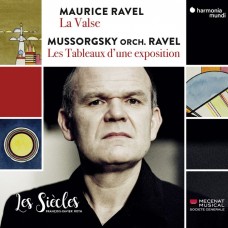|
拉威爾: 圓舞曲 / 穆索斯基: 展覽會之畫
芳斯瓦-澤維爾.羅斯 指揮
世紀樂團
指揮家托斯卡尼尼認為認為(展覽會之畫)的編曲是一份真正的樂器配器的論文, 而能與之相提並論的是白遼士以同樣的樂器威力譜曲的(圓舞曲). 拉威爾改編的(展覽會之畫)管弦樂版本很快的超越了其他所有競爭版本的穆索斯基鋼琴組曲. 依照芳斯瓦-澤維爾.羅斯的觀點, (展覽會之畫)和(圓舞曲)一起代表著在作曲家們的年代時寫給交響樂團的巔峰創作 – 也就是說, 當世紀樂團的音樂家們在今日為我們重現這些作品時, 能夠回到這些音樂的原始色彩是多麼愉快的事.
Toscanini regarded this orchestration of Pictures at an Exhibition as a genuine treatise on instrumentation, on a par with that of Berlioz: scored for the same instrumental forces as La Valse, Ravel's version quickly established itself ahead of all the many competing orchestrations of Mussorgsky's piano suite! In François-Xavier Roth's view, La Valse and the Pictures together represent the peak of the composer's output for the symphony orchestra of his time – that is to say, as the musicians of Les Siecles reconstruct it for us today. What a joy to get back to the original colours of this music!
Tableaux d'une exposition
1 Promenade I (orch. Maurice Ravel) 01:33
2 1. Gnomus (orch. Maurice Ravel) 02:28
3 Promenade II (orch. Maurice Ravel) 58
4 2. Il vecchio castello (orch. Maurice Ravel) 04:19
5 Promenade III (orch. Maurice Ravel) 32
6 3. Tuileries (Dispute d'enfants apres jeux) (orch. Maurice Ravel) 01:09
7 4. Bydło (orch. Maurice Ravel) 03:07
8 Promenade IV (orch. Maurice Ravel) 40
9 5. Ballet des poussins dans leurs coques (orch. Maurice Ravel) 01:16
10 6. Samuel Goldenberg et Schmuÿle (orch. Maurice Ravel) 02:16
11 7. Limoges – Le Marche (la grande nouvelle) (orch. Maurice Ravel) 01:19
12 8. Catacombæ (Sepulcrum Romanum) (orch. Maurice Ravel) 01:45
13 Cum mortuis in lingua mortua (orch. Maurice Ravel) 01:53
14 9. La Cabane sur des pattes de poule. Baba-Yaga (orch. Maurice Ravel) 03:21
15 10. La Grande Porte de Kiev (orch. Maurice Ravel) 05:05
16 La Valse, poeme choregraphique, M. 72 12:17 |
|



